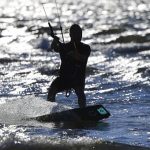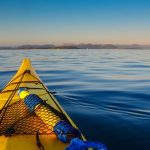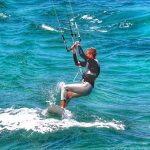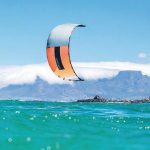Kitesurfing is becoming increasingly popular as an extreme sport, and it’s no surprise why; it’s thrilling, easy to master and, most importantly, enjoyable!
Some individuals may experience a bit of difficulty when starting out with kitesurfing, however, one can move swiftly from being a total rookie to having an enjoyable time.
You need to make sure you have the right equipment (e.g. a proper kite, board, and harness) and are in a good place to learn and have a qualified kiteboarding teacher.
HOW FIT DO I NEED TO BE TO KITESURF?
It is not necessary to have great physical fitness in order to kitesurf, contrary to what is commonly assumed. It is common to observe young children around 10 years old out on the water.
Ladies should not be discouraged by the assumption that having huge biceps is necessary.
It is absolutely accurate that, with the appropriate kite, practically anyone can partake in kitesurfing.
Rather than being your arms that are doing the hard work, the strain of flying a kite is actually taken up by your harness; it’s your core muscles that get the exercise.
You should be confident while in the water and possess an adequate amount of physical fitness.
HOW MUCH DOES IT COST TO GET INTO KITESURFING?
You need the following equipment to kitesurf: a kite, control bar and lines, a body harness, and a board.
You should plan on spending between £1500 and £2000 GBP / €1700 and €2300 EUR for a complete set of gear, depending on the type and quality you desire.
If you choose to buy the model from the year before, you can usually get a great deal of 30 to 40% off the suggested retail price.
You can find plenty of used equipment, and it can all be obtained for approximately 500 British Pounds or 580 Euros.
When purchasing a used kite, you should be aware of when it was made. In recent times, kites have undergone a considerable transformation in terms of performance, with newer models outperforming those that are 5 years old.
Kites that are more aged are likely to have less of a capability to reduce power, which is an important safety element, and are more challenging to get airborne again.
In addition to the kite gear, a wetsuit and possibly neoprene booties are needed, as well as a helmet and a buoyancy device.
If you’re looking to purchase something new, you should expect to spend around £250-£300 for everything.
If you are eager to begin and keep up with kitesurfing, we suggest that you take a 3-day kitesurf course to be more self-sufficient.
You should be ready to spend around 290 British Pounds or 330 Euros for a package that includes four hours of instruction and all the necessary equipment.
HOW LONG DOES IT TAKE TO LEARN HOW TO KITESURF?
It is possible to be comfortable and able to ride within three days.
Kitesurfing is surprisingly simple, despite its intimidating outward appearance. If you have already experienced power kiting, skateboarding, snowboarding, or wakeboarding, you are almost done learning how to do it.
Typically, a course that lasts three days, with four hours of instruction each day, should give you the skills and confidence to ride.
You should strive to have as many practice sessions as possible to reinforce your abilities and become confident in sailing upwind.
Having the capability to sail against the wind allows you to remain in a safe area, evade any potential risks, and return to your point of origin.
Follow this 11-step guide to fast-track your kitesurf progression. You can cut back on expensive lessons that are unnecessary and eliminate the aggravation of the initial period of learning…
11 steps to learning kitesurfing for beginners
1. Learn to fly a trainer kite
A person can use a small kite of 2 to 3 meters in length to practice kite flying before attempting it on the water.
This kite is known as a trainer kite. Gaining insight into the wind window and power zone is a great approach to becoming knowledgeable about kitesurfing.
Kites that use traction typically have either two or four lines attached to them, however, there are some models like the Ozone Ignition which use three lines, and the third line serves a safety purpose.
A 3 square meter kite is a good choice, however, be careful in windy conditions as even this small size can lift you up.
If you master your basic kite skills on a trainer kite before your kitesurfing lessons, you’ll save loads of time and money.
And you can always use it later for mountain boarding or snow kiting, or lend it to friends when you’re out on the water!
2. Dig out your old skateboard
It is quite common for people to excel in multiple boardsports such as wakeboarding, skateboarding, surfing, and snowboarding, which will make it much easier to learn how to kiteboard.
Being familiar with the board allows you to concentrate on controlling the kite instead of having to worry about staying steady on the board.
There is no doubt that wakeboarding is comparable to kitesurfing, due to the fact that the board used is almost identical. Go to your closest cable-ski facility and become good at using a wakeboard.
It’s an infallible method to expedite your advancement during your kitesurfing classes.
3. Watch some instructional kitesurfing videos
View as much footage as you can on how to kitesurf. When you take lessons, they will be tremendously beneficial in aiding your growth.
There are plenty of excellent videos available that give you a fundamental understanding.
I strongly advise you to look into Progression’s instructional kitesurfing series which offers five videos that enable you to transition from novice to expert, and can be accessed either on DVD or as a digital download.
Take a look at YouTube; it won’t hurt to watch some different videos on the same topic. It is important to bear in mind that videos should not be used instead of professional kiteboarding instruction.
The Progression Sports videos are designed to help you get prepared for your lessons or to help jog your memory of what you have been taught in class.
The course covers:
- Location and Conditions
- Equipment and Terminology
- Kite Set Up
- Launching and Landing the Kite
- Body Dragging (including upwind body dragging)
- Water Re-Launch and Self-Rescue
- Waterstarts and First Runs
- Riding and Staying Upwind
- Changing Direction
4. Find a good kite surfing school
There are kite surfing schools throughout the Netherlands.
It is advantageous and practical to pick a school near you or in an area you would like to go kite surfing in following classes.
Then, you figure out how to manage the specific conditions in that place, like gusts of wind, eddies, and other individuals who are present there.
Are there no schools near you? It may be that the kitesurf shop offers lessons. You can also combine a vacation with learning by taking lessons abroad.
It is advised that you go to a kite surfing school with certified instructors if given the chance.
For example by the International Kiteboarding Organization (IKO). The IKO (International Kiteboarding Organization) was established in 2001 and is focused on promoting the secure growth of the sport.
Kite surfing regulations and certification for instructors and people wanting to learn kite surfing are applicable worldwide.
The major benefit of having an international kitesurfing license is that you can obtain gear for the sport in any part of the world.
5. Become familiar with the kite during kitesurfing lessons
Begin your experience with a training or power kite on the ground. They are slightly reduced in size so that you can become accustomed to the power exerted by the kite.
You figure out how to manipulate the kite, build tension and then release it again. If you’re okay with it, you can move on to a standard kite.
You will be given additional information regarding safety and the subject matter.
Common themes that are talked about include: the form, the material it’s made of, the way to blow it up and how firm it is, as well as how to arrange and secure the ropes.
Next, the challenging task commences: maneuvering the kite surfing kite along with all its related components. This is all still on land.
6. On the water during kitesurfing lesson
You enter the water with a kite, but no board, under the guidance of the teacher. There you go bodydragging.
Then you maneuver the kite in a manner that it drags you across the water. If this is successful, you will be assigned tasks to guide it in a particular direction.
The paths are becoming increasingly complex requiring you to handle the kite at a progressively challenging angle. You also need this skill during kite surfing.
For instance, if you slip and lose your board, you will have to swim to get back to it. Experiencing the sensation of being dragged through the water can be exhilarating and enjoyable.
Although a sip of (sea) water is often unavoidable.
Is body wear okay? Then you start to start. Now you are determined to attempt to kite surf your first few meters.
An instructor may first have you practice kitesurfing by standing up from a seated position (conjuring an imaginary kite surfboard) when the kite is sent out and the power is reduced.
You may also attempt to begin kitesurfing right away in the water, with the support of a kitesurfing instructor. Don’t get anxious if it doesn’t succeed right away or takes a while.
That does not indicate whether you will become proficient in this activity. From this point on it is a long haul. Practice, practice and practice again is the recipe.
7. Follow your kitesurfing course. How many kitesurfing lessons do I need?
The amount of lessons you require could range from 4 to over 15 hours. At times, it can be quicker to learn because of prior experience in related aquatic or board activities.
Does it require more time to get accustomed to the material and to become confident with it?
8. Determine which kitesurfing equipment suits you
It can be tricky for beginners and those who are getting back into kite surfing to locate the proper kite surfing set or kite surfing gear that fits their expertise.
It isn’t unexpected, as when you are a novice kite surfer or a person coming back to the sport, you usually don’t know precisely what you need.
The kite surfing stores typically assemble kits specifically tailored for beginning and experienced kite surfers.
These kite surfing gear is usually available at a competitive cost. Enough inspiration to find. A quick phone call or trip to a kite surfing store can be done in no time.
Personal advice often works best. You can also get the information you need by speaking to your kitesurfing instructor.
At the conclusion of the kitesurfing lesson, he will be able to advise you on which type of kitesurfing gear is the most appropriate for you. In addition, due to their enthusiasm for kite surfing, they are usually willing to give you tips.
9. Purchase of kite surfing equipment
Having the right gear is essential for your enjoyment and well-being while on the water. Do not buy materials until after you have finished the lessons.
10. Practice, practice and practice again
Practice, practice and practice again. That starts with finding a suitable location. The Dutch Kitesurf Association’s website contains information about various places. As a beginner, search for:
- Calm water. Make sure you are never alone, but pressure water with many others is also not convenient.
- Shallow water. Make sure you can stand there, but that it is not shallower than knee deep.
- Water without currents and waves. You already have enough to worry about. Hopefully these two will come later.
- A place with few or no obstacles in the water or on the shore. Obstacles downwind close to you is a no-go.
- Preferably a place with a sandy bottom. A bottom with stones, shells or, abroad, coral can be dangerous. Then make sure you have surf shoes to protect your feet and kite surf where it is deep enough so that you cannot injure yourself on the bottom if you fall.
Waiting for the perfect wind
The ideal conditions for kite surfing are a wind speed of 14 to 22 knots (or wind force 4 to 6). Your kite has a good amount of tension, however, it is not very strong yet.
A favorable and safe wind direction. This applies to all places, but certainly by the sea:
- Safest: side-onshore wind. The wind blows diagonally towards the side. You will then leave, but you will always return.
- Less safe: side-shore wind. The wins blow parallel to the waterline. You can consider going, but be careful not to go too far. If you get in trouble, you float past the kite spot and not go there.
- Sometimes safe: onshore / onshore wind. The wind is straight on the shore. You run the risk of being pulled aside if something goes wrong. Is it far shallow but deeper than knee depth? Then there is still a safe distance to the shore and you can sail.
- Not safe: offshore / offshore wind. The wind blows away from the shore. This is a no-go. Because if the wind is too strong or something goes wrong, you will be pulled off the side. It may become impossible to come back.
in conclusion
kitesurfing is an extraordinary sport that opens up a world of exhilaration and freedom for beginners.
It’s a thrilling experience that combines the power of wind, the rush of the waves, and the joy of gliding across the water.
Whether you’re seeking an adrenaline-pumping adventure or a peaceful connection with nature, kitesurfing offers something for everyone.
As a beginner, it’s essential to start your kitesurfing journey on the right foot.
Invest in professional lessons from certified instructors who will teach you the fundamental skills, safety protocols, and techniques necessary to become a competent rider.
Their expertise will fast-track your progress and ensure a safe and enjoyable learning experience.
Don’t be discouraged by the initial challenges. Kitesurfing is a skill that requires practice, patience, and perseverance.
Embrace the learning process, celebrate small victories, and always prioritize safety. Soon enough, you’ll find yourself harnessing the wind, mastering control, and gliding effortlessly across the water.
Remember, kitesurfing is not just a sport—it’s a lifestyle. It fosters a vibrant community of like-minded individuals who share a passion for adventure and a love for the elements.
Embrace the camaraderie, connect with fellow riders, and seek out kitesurfing destinations around the world to explore new horizons.
With each session on the water, you’ll gain confidence, strength, and a profound appreciation for the beauty and power of nature.
The adrenaline rush and the sheer joy of defying gravity will leave you craving more, pushing you to continuously improve and evolve as a kitesurfer.
So, if you’re ready to embark on an unforgettable journey, don’t hesitate to dive into the world of kitesurfing.
Let the wind be your guide as you soar to new heights and discover the boundless possibilities that await you.
Whether you’re riding the waves of a tropical paradise or exploring the shores of your local beach, kitesurfing for beginners promises a life-changing experience that will forever ignite your spirit of adventure.
Get ready to write your own story—one filled with thrilling rides, breathtaking views, and unforgettable memories.
The world of kitesurfing eagerly awaits your presence. Embrace the wind, chase the waves, and let your kitesurfing journey begin!
FAQ
Here are some frequently asked questions I get from people looking to start learning kitesurfing…
Q: Is kitesurfing suitable for beginners?
A: Absolutely! Kitesurfing can be enjoyed by beginners with the right training, equipment, and guidance. Starting with proper lessons from certified instructors is essential to ensure a safe and enjoyable experience.
Q: What equipment do I need to start kitesurfing?
A: As a beginner, you will need a few essential pieces of equipment, including a kite, a control bar, a harness, a board, and safety gear such as a helmet and a life jacket. It’s important to invest in high-quality equipment that is suitable for beginners and matches your skill level.
Q: Do I need any prior experience to learn kitesurfing?
A: No prior experience is necessary to start learning kitesurfing. However, having a basic understanding of wind patterns and some water sports experience can be helpful. Qualified instructors will teach you everything you need to know, from kite control to board skills, during your lessons.
Q: Is kitesurfing a dangerous sport?
A: Like any adventure sport, kitesurfing has some inherent risks. However, with proper training, safety precautions, and adherence to guidelines, the risks can be significantly minimized. Learning from certified instructors and respecting weather conditions and safety protocols is crucial to ensuring your safety on the water.
Q: How long does it take to learn kitesurfing?
A: The learning curve for kitesurfing varies from person to person, depending on factors such as athleticism, previous water sports experience, and dedication to practice. Generally, beginners can expect to spend around 10 to 15 hours of lessons to acquire the basic skills and become proficient enough to ride independently.
Q: Can I kitesurf in any weather conditions?
A: Kitesurfing is highly dependent on weather conditions, particularly wind strength and direction. It is important to understand and respect wind conditions that are suitable for your skill level. Light to moderate winds of around 10 to 25 knots are generally considered ideal for beginners.
Q: Can I kitesurf alone after completing lessons?
A: After completing your lessons, you will gain the necessary skills to kitesurf independently. However, it’s always recommended to kitesurf with a buddy or in the presence of other experienced riders for added safety. Kitesurfing with a community or joining organized sessions can enhance your overall experience.
Q: Are there any age restrictions for learning kitesurfing?
A: While there is no specific age limit for learning kitesurfing, it’s important to assess an individual’s physical fitness, strength, and ability to follow instructions. Some kitesurfing schools may have their own age restrictions or guidelines for minors, so it’s best to check with your chosen school beforehand.
Remember, learning to kitesurf is an exciting journey that requires patience, dedication, and a passion for adventure.
Always prioritize safety, seek proper training, and enjoy the incredible experience of harnessing the wind and gliding across the water.




